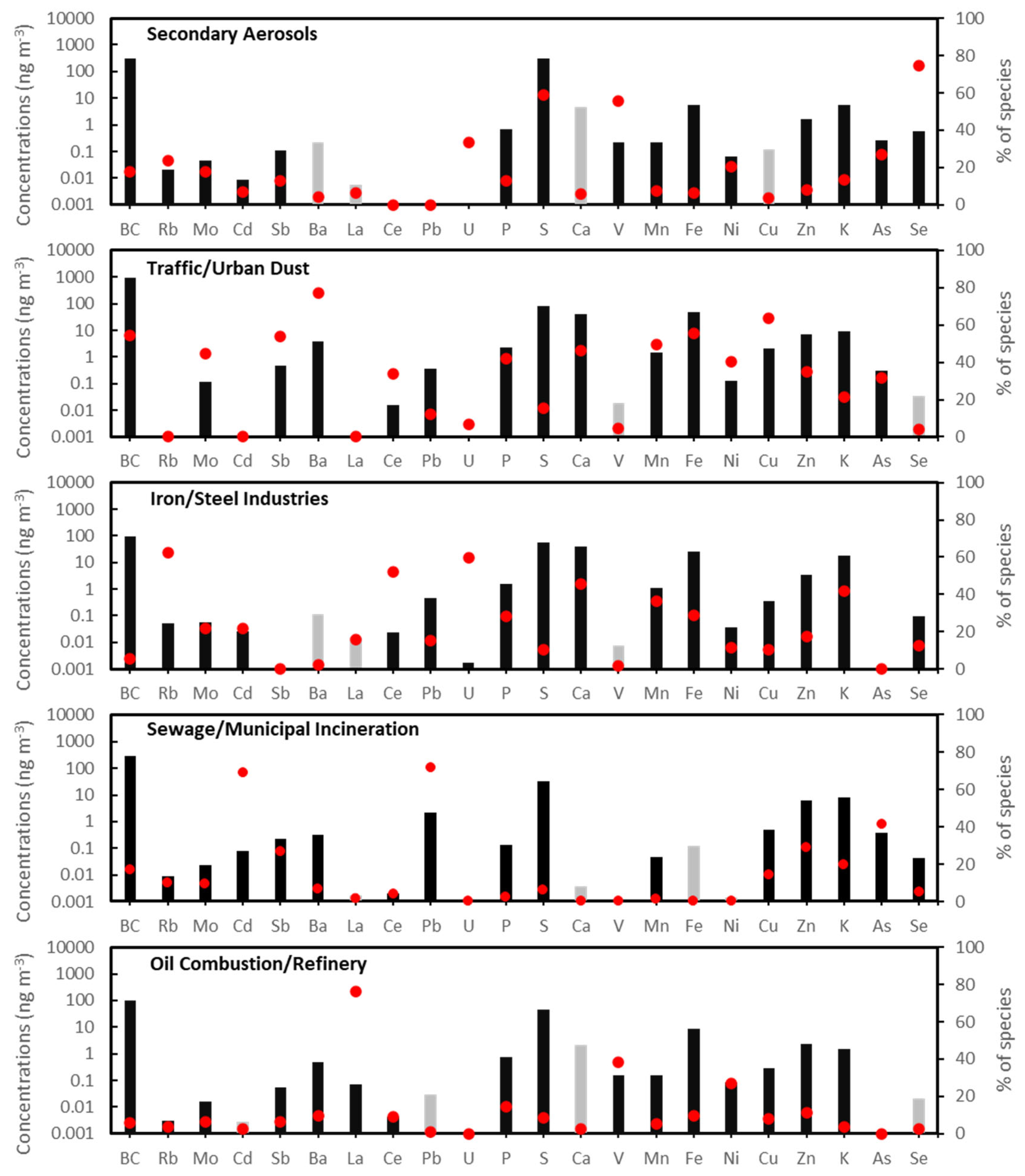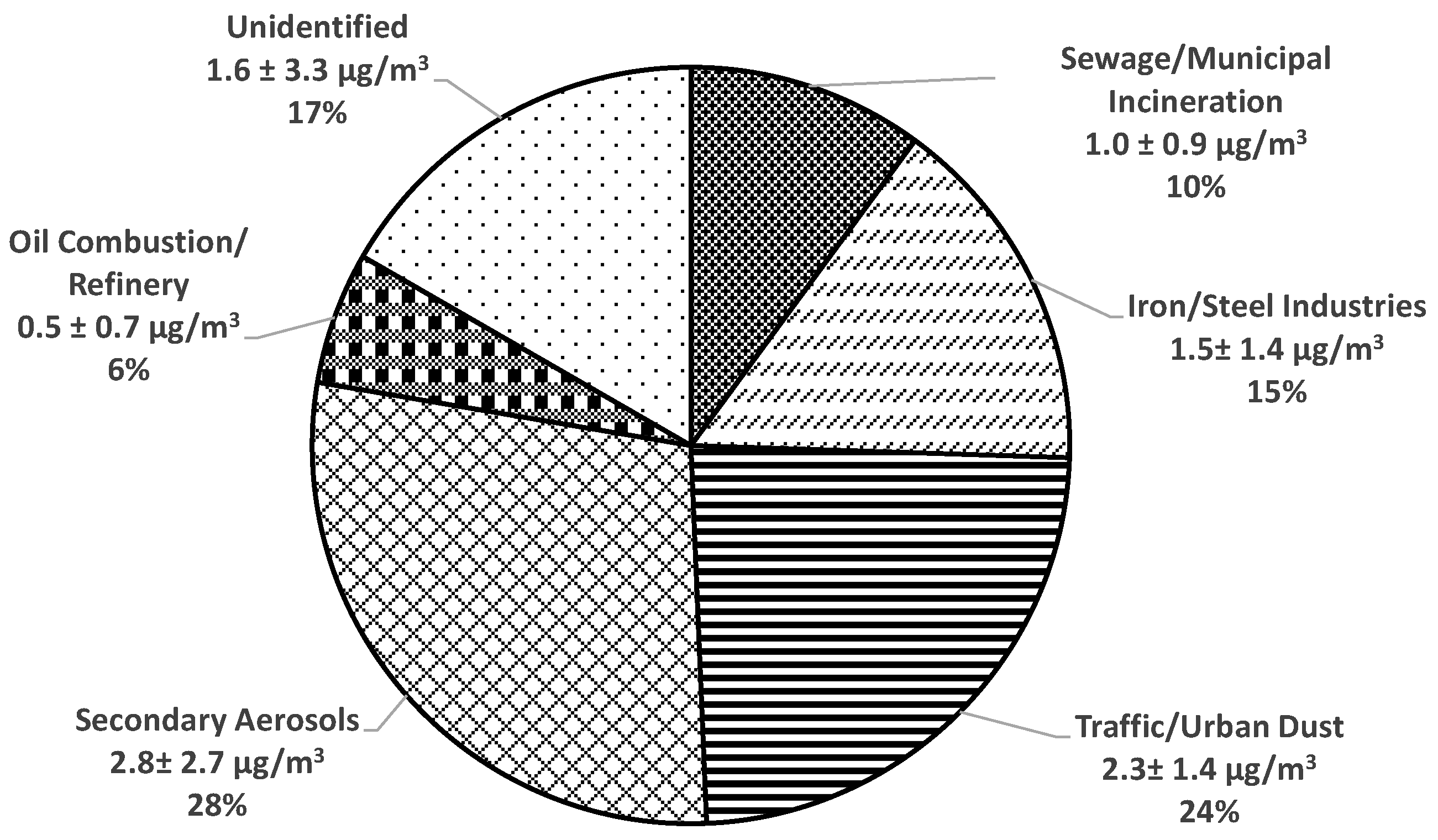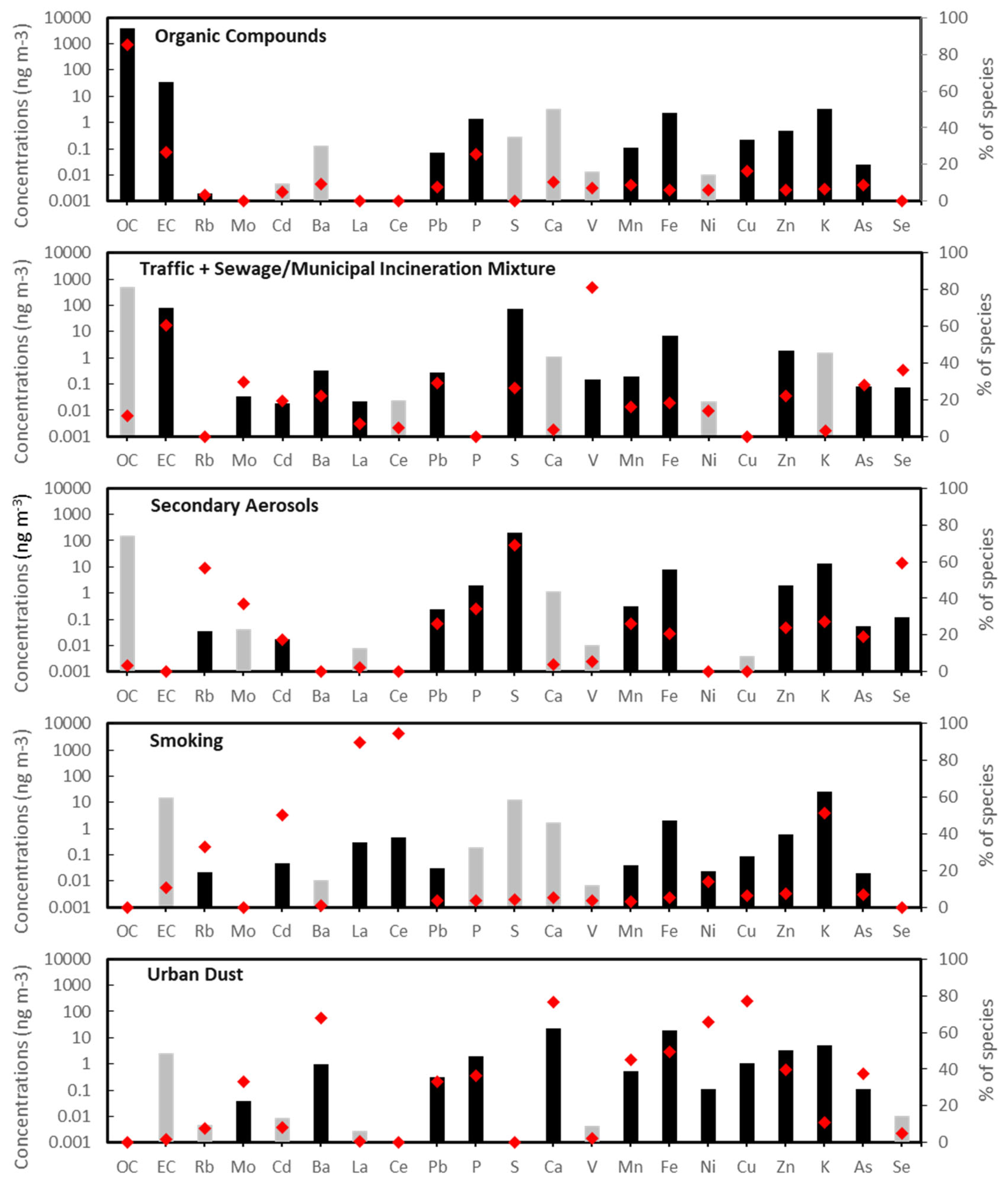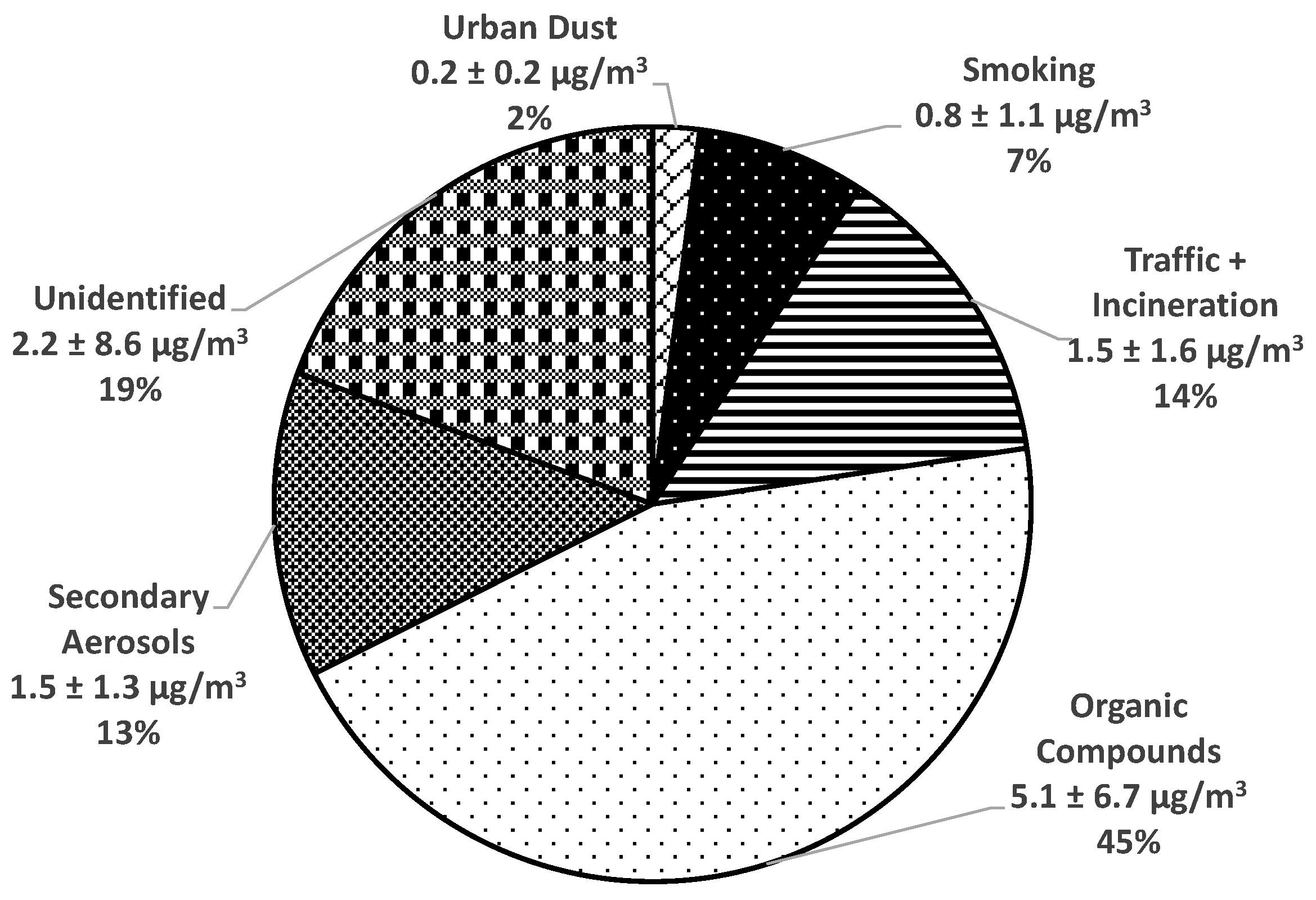Reduction of Outdoor and Indoor PM2.5 Source Contributions via Portable Air Filtration Systems in a Senior Residential Facility in Detroit, Michigan
Abstract
:1. Introduction
2. Methods
2.1. Intervention
2.2. Sampling
2.3. Mass and Chemical Analyses
2.4. Data Analysis
3. Results and Discussion
3.1. Major Sources of Outdoor PM2.5
3.2. Major Sources of Indoor PM2.5
3.3. Effectiveness of PAFs against Outdoor PM2.5 Infiltration
3.4. Limitations of This Study
4. Conclusions
Supplementary Materials
Author Contributions
Funding
Institutional Review Board Statement
Informed Consent Statement
Data Availability Statement
Acknowledgments
Conflicts of Interest
References
- Wang, C.; Tu, Y.; Yu, Z.; Lu, R. PM2.5 and Cardiovascular Diseases in the Elderly: An Overview. Int. J. Environ. Res. Public. Health 2015, 12, 8187–8197. [Google Scholar] [CrossRef]
- Fajersztajn, L.; Saldiva, P.; Pereira, L.A.A.; Leite, V.F.; Buehler, A.M. Short-Term Effects of Fine Particulate Matter Pollution on Daily Health Events in Latin America: A Systematic Review and Meta-Analysis. Int. J. Public Health 2017, 62, 729–738. [Google Scholar] [CrossRef] [PubMed]
- Luo, C.; Zhu, X.; Yao, C.; Hou, L.; Zhang, J.; Cao, J.; Wang, A. Short-Term Exposure to Particulate Air Pollution and Risk of Myocardial Infarction: A Systematic Review and Meta-Analysis. Environ. Sci. Pollut. Res. 2015, 22, 14651–14662. [Google Scholar] [CrossRef] [PubMed]
- WHO. Health Effects of Particulate Matter: Policy Implications for Countries in Eastern Europe, Caucasus, and Central Asia; WHO Regional Office for Europe UN: Copenhagen, Denmark, 2013. [Google Scholar]
- Lederer, A.M.; Fredriksen, P.M.; Nkeh-Chungag, B.N.; Everson, F.; Strijdom, H.; De Boever, P.; Goswami, N. Cardiovascular Effects of Air Pollution: Current Evidence from Animal and Human Studies. Am. J. Physiol.-Heart Circ. Physiol. 2021, 320, H1417–H1439. [Google Scholar] [CrossRef] [PubMed]
- Newman, J.D.; Bhatt, D.L.; Rajagopalan, S.; Balmes, J.R.; Brauer, M.; Breysse, P.N.; Brown, A.G.M.; Carnethon, M.R.; Cascio, W.E.; Collman, G.W.; et al. Cardiopulmonary Impact of Particulate Air Pollution in High-Risk Populations. J. Am. Coll. Cardiol. 2020, 76, 2878–2894. [Google Scholar] [CrossRef]
- Di, Q.; Wang, Y.; Zanobetti, A.; Wang, Y.; Koutrakis, P.; Choirat, C.; Dominici, F.; Schwartz, J.D. Air Pollution and Mortality in the Medicare Population. N. Engl. J. Med. 2017, 376, 2513–2522. [Google Scholar] [CrossRef] [PubMed]
- Di, Q.; Dai, L.; Wang, Y.; Zanobetti, A.; Choirat, C.; Schwartz, J.D.; Dominici, F. Association of Short-Term Exposure to Air Pollution with Mortality in Older Adults. JAMA 2017, 318, 2446–2456. [Google Scholar] [CrossRef]
- Thurston, G.D.; Ahn, J.; Cromar, K.R.; Shao, Y.; Reynolds, H.R.; Jerrett, M.; Lim, C.C.; Shanley, R.; Park, Y.; Hayes, R.B. Ambient Particulate Matter Air Pollution Exposure and Mortality in the NIH-AARP Diet and Health Cohort. Environ. Health Perspect. 2016, 124, 484–490. [Google Scholar] [CrossRef]
- Chen, R.; Zhao, A.; Chen, H.; Zhao, Z.; Cai, J.; Wang, C.; Yang, C.; Li, H.; Xu, X.; Ha, S.; et al. Cardiopulmonary Benefits of Reducing Indoor Particles of Outdoor Origin: A Randomized, Double-Blind Crossover Trial of Air Purifiers. J. Am. Coll. Cardiol. 2015, 65, 2279–2287. [Google Scholar] [CrossRef]
- Allen, R.W.; Carlsten, C.; Karlen, B.; Leckie, S.; van Eeden, S.; Vedal, S.; Wong, I.; Brauer, M. An Air Filter Intervention Study of Endothelial Function among Healthy Adults in a Woodsmoke-Impacted Community. Am. J. Respir. Crit. Care Med. 2011, 183, 1222–1230. [Google Scholar] [CrossRef]
- Bräuner, E.V.; Forchhammer, L.; Møller, P.; Barregard, L.; Gunnarsen, L.; Afshari, A.; Wåhlin, P.; Glasius, M.; Dragsted, L.O.; Basu, S.; et al. Indoor Particles Affect Vascular Function in the Aged. Am. J. Respir. Crit. Care Med. 2008, 177, 419–425. [Google Scholar] [CrossRef] [PubMed]
- Kajbafzadeh, M.; Brauer, M.; Karlen, B.; Carlsten, C.; van Eeden, S.; Allen, R.W. The Impacts of Traffic-Related and Woodsmoke Particulate Matter on Measures of Cardiovascular Health: A HEPA Filter Intervention Study. Occup. Environ. Med. 2015, 72, 394–400. [Google Scholar] [CrossRef] [PubMed]
- Weichenthal, S.; Mallach, G.; Kulka, R.; Black, A.; Wheeler, A.; You, H.; St-Jean, M.; Kwiatkowski, R.; Sharp, D. A Randomized Double-Blind Crossover Study of Indoor Air Filtration and Acute Changes in Cardiorespiratory Health in a First Nations Community. Indoor Air 2013, 23, 175–184. [Google Scholar] [CrossRef]
- Spilak, M.P.; Karottki, G.D.; Kolarik, B.; Frederiksen, M.; Loft, S.; Gunnarsen, L. Evaluation of Building Characteristics in 27 Dwellings in Denmark and the Effect of Using Particle Filtration Units on PM2.5 Concentrations. Build. Environ. 2014, 73, 55–63. [Google Scholar] [CrossRef]
- Karottki, D.G.; Spilak, M.; Frederiksen, M.; Gunnarsen, L.; Brauner, E.V.; Kolarik, B.; Andersen, Z.J.; Sigsgaard, T.; Barregard, L.; Strandberg, B.; et al. An Indoor Air Filtration Study in Homes of Elderly: Cardiovascular and Respiratory Effects of Exposure to Particulate Matter. Environ. Health 2013, 12, 116. [Google Scholar] [CrossRef]
- Matz, C.J.; Stieb, D.M.; Davis, K.; Egyed, M.; Rose, A.; Chou, B.; Brion, O. Effects of Age, Season, Gender and Urban-Rural Status on Time-Activity: Canadian Human Activity Pattern Survey 2 (CHAPS 2). Int. J. Environ. Res. Public Health 2014, 11, 2108–2124. [Google Scholar] [CrossRef]
- USEPAO. Indoor Air Quality. Available online: https://www.epa.gov/report-environment/indoor-air-quality (accessed on 28 November 2023).
- Morishita, M.; Adar, S.D.; D’Souza, J.; Ziemba, R.A.; Bard, R.L.; Spino, C.; Brook, R.D. Effect of Portable Air Filtration Systems on Personal Exposure to Fine Particulate Matter and Blood Pressure Among Residents in a Low-Income Senior Facility: A Randomized Clinical Trial. JAMA Intern. Med. 2018, 178, 1350–1357. [Google Scholar] [CrossRef]
- Maestas, M.M.; Brook, R.D.; Ziemba, R.A.; Li, F.; Crane, R.C.; Klaver, Z.M.; Bard, R.L.; Spino, C.A.; Adar, S.D.; Morishita, M. Reduction of Personal PM2.5 Exposure via Indoor Air Filtration Systems in Detroit: An Intervention Study. J. Expo. Sci. Environ. Epidemiol. 2019, 29, 484–490. [Google Scholar] [CrossRef] [PubMed]
- Harkema, J.R.; Wagner, J.G.; Kaminski, N.E.; Morishita, M.; Keeler, G.J.; McDonald, J.D.; Barrett, E.G.; HEI Health Review Committee. Effects of Concentrated Ambient Particles and Diesel Engine Exhaust on Allergic Airway Disease in Brown Norway Rats. Res. Rep. Health Eff. Inst. 2009, 145, 5–55. [Google Scholar]
- Norris, G.; Duvall, R.; Brown, S.; Bai, S. Positive Matrix Factorization (PMF) 5.0 Fundamentals and User Guide 2014; US Environmental Protection Agency: Petaluma, CA, USA, 2014. [Google Scholar]
- Brehmer, C.; Norris, C.; Barkjohn, K.K.; Bergin, M.H.; Zhang, J.; Cui, X.; Zhang, Y.; Black, M.; Li, Z.; Shafer, M.; et al. The Impact of Household Air Cleaners on the Chemical Composition and Children’s Exposure to PM2.5 Metal Sources in Suburban Shanghai. Environ. Pollut. 2019, 253, 190–198. [Google Scholar] [CrossRef]
- Paatero, P.; Hopke, P.K.; Hoppenstock, J.; Eberly, S.I. Advanced Factor Analysis of Spatial Distributions of PM2.5 in the Eastern United States. Environ. Sci. Technol. 2003, 37, 2460–2476. [Google Scholar] [CrossRef]
- Morishita, M.; Bard, R.L.; Kaciroti, N.; Fitzner, C.A.; Dvonch, T.; Harkema, J.R.; Rajagopalan, S.; Brook, R.D. Exploration of the Composition and Sources of Urban Fine Particulate Matter Associated with Same-Day Cardiovascular Health Effects in Dearborn, Michigan. J. Expo. Sci. Environ. Epidemiol. 2015, 25, 145–152. [Google Scholar] [CrossRef] [PubMed]
- USEPA. National Emission Inventory (NEI) Report; USEPA: Washington, DC, USA, 2016. [Google Scholar]
- USEPAUS. AirData. Available online: https://aqs.epa.gov/aqsweb/airdata/download_files.html (accessed on 11 July 2019).
- Squizzato, S.; Masiol, M.; Rich, D.Q.; Hopke, P.K. A Long-Term Source Apportionment of PM2.5 in New York State during 2005–2016. Atmos. Environ. 2018, 192, 35–47. [Google Scholar] [CrossRef]
- Cesari, D.; Genga, A.; Ielpo, P.; Siciliano, M.; Mascolo, G.; Grasso, F.M.; Contini, D. Source Apportionment of PM2.5 in the Harbour–Industrial Area of Brindisi (Italy): Identification and Estimation of the Contribution of in-Port Ship Emissions. Sci. Total Environ. 2014, 497–498, 392–400. [Google Scholar] [CrossRef] [PubMed]
- Pandolfi, M.; Gonzalez-Castanedo, Y.; Alastuey, A.; de la Rosa, J.D.; Mantilla, E.; de la Campa, A.S.; Querol, X.; Pey, J.; Amato, F.; Moreno, T. Source Apportionment of PM10 and PM2.5 at Multiple Sites in the Strait of Gibraltar by PMF: Impact of Shipping Emissions. Environ. Sci. Pollut. Res. 2011, 18, 260–269. [Google Scholar] [CrossRef]
- Masiol, M.; Hopke, P.K.; Felton, H.D.; Frank, B.P.; Rattigan, O.V.; Wurth, M.J.; LaDuke, G.H. Source Apportionment of PM2.5 Chemically Speciated Mass and Particle Number Concentrations in New York City. Atmos. Environ. 2017, 148, 215–229. [Google Scholar] [CrossRef]
- Yan, G.; Mao, L.; Jiang, B.; Chen, X.; Gao, Y.; Chen, C.; Li, F.; Chen, L. The Source Apportionment, Pollution Characteristic and Mobility of Sb in Roadside Soils Affected by Traffic and Industrial Activities. J. Hazard. Mater. 2020, 384, 121352. [Google Scholar] [CrossRef] [PubMed]
- Lim, J.-M.; Lee, J.-H.; Moon, J.-H.; Chung, Y.-S.; Kim, K.-H. Source Apportionment of PM10 at a Small Industrial Area Using Positive Matrix Factorization. Atmos. Res. 2010, 95, 88–100. [Google Scholar] [CrossRef]
- gon Ryou, H.; Heo, J.; Kim, S.-Y. Source Apportionment of PM10 and PM2.5 Air Pollution, and Possible Impacts of Study Characteristics in South Korea. Environ. Pollut. 2018, 240, 963–972. [Google Scholar] [CrossRef]
- Schauer, J.J.; Lough, G.C.; Shafer, M.M.; Christensen, W.F.; Arndt, M.F.; DeMinter, J.T.; Park, J.-S. Characterization of Metals Emitted from Motor Vehicles. Res. Rep. Health Eff. Inst. 2006, 133, 1–76; discussion 77–78. [Google Scholar]
- Yu, S.; Liu, W.; Xu, Y.; Yi, K.; Zhou, M.; Tao, S.; Liu, W. Characteristics and Oxidative Potential of Atmospheric PM2.5 in Beijing: Source Apportionment and Seasonal Variation. Sci. Total Environ. 2019, 650, 277–287. [Google Scholar] [CrossRef]
- Lawrence, S.; Sokhi, R.; Ravindra, K.; Mao, H.; Prain, H.D.; Bull, I.D. Source Apportionment of Traffic Emissions of Particulate Matter Using Tunnel Measurements. Atmos. Environ. 2013, 77, 548–557. [Google Scholar] [CrossRef]
- Lopez, B.; Wang, X.; Chen, L.-W.A.; Ma, T.; Mendez-Jimenez, D.; Cobb, L.C.; Frederickson, C.; Fang, T.; Hwang, B.; Shiraiwa, M.; et al. Metal Contents and Size Distributions of Brake and Tire Wear Particles Dispersed in the Near-Road Environment. Sci. Total Environ. 2023, 883, 163561. [Google Scholar] [CrossRef]
- Almeida, S.M.; Lage, J.; Fernández, B.; Garcia, S.; Reis, M.A.; Chaves, P.C. Chemical Characterization of Atmospheric Particles and Source Apportionment in the Vicinity of a Steelmaking Industry. Sci. Total Environ. 2015, 521–522, 411–420. [Google Scholar] [CrossRef] [PubMed]
- Kfoury, A.; Ledoux, F.; Roche, C.; Delmaire, G.; Roussel, G.; Courcot, D. PM2.5 Source Apportionment in a French Urban Coastal Site under Steelworks Emission Influences Using Constrained Non-Negative Matrix Factorization Receptor Model. J. Environ. Sci. 2016, 40, 114–128. [Google Scholar] [CrossRef] [PubMed]
- Kim, M.; Deshpande, S.R.; Crist, K.C. Source Apportionment of Fine Particulate Matter (PM2.5) at a Rural Ohio River Valley Site. Atmos. Environ. 2007, 41, 9231–9243. [Google Scholar] [CrossRef]
- Geagea, M.; Stille, P.; Gauthier-Lafaye, F.; Millet, M. Tracing of Industrial Aerosol Sources in an Urban Environment Using Pb, Sr, and Nd Isotopes. Environ. Sci. Technol. 2008, 42, 692–698. [Google Scholar] [CrossRef]
- Zhang, Y.; Wang, X.; Chen, H.; Yang, X.; Chen, J.; Allen, J.O. Source Apportionment of Lead-Containing Aerosol Particles in Shanghai Using Single Particle Mass Spectrometry. Chemosphere 2009, 74, 501–507. [Google Scholar] [CrossRef] [PubMed]
- Tang, Z.; Liu, M.; Yi, L.; Guo, H.; Ouyang, T.; Yin, H.; Li, M. Source Apportionment and Health Risk Assessment of Heavy Metals in Eastern Guangdong Municipal Solid Waste. Appl. Sci. 2019, 9, 4755. [Google Scholar] [CrossRef]
- Ma, W.; Tai, L.; Qiao, Z.; Zhong, L.; Wang, Z.; Fu, K.; Chen, G. Contamination Source Apportionment and Health Risk Assessment of Heavy Metals in Soil around Municipal Solid Waste Incinerator: A Case Study in North China. Sci. Total Environ. 2018, 631–632, 348–357. [Google Scholar] [CrossRef]
- Charlesworth, S.; Everett, M.; McCarthy, R.; Ordóñez, A.; de Miguel, E. A Comparative Study of Heavy Metal Concentration and Distribution in Deposited Street Dusts in a Large and a Small Urban Area: Birmingham and Coventry, West Midlands, UK. Environ. Int. 2003, 29, 563–573. [Google Scholar] [CrossRef]
- Tehrani, M.W.; Fortner, E.C.; Robinson, E.S.; Chiger, A.A.; Sheu, R.; Werden, B.S.; Gigot, C.; Yacovitch, T.; Van Bramer, S.; Burke, T.; et al. Characterizing metals in particulate pollution in communities at the fenceline of heavy industry: Combining mobile monitoring and size-resolved filter measurements. Environ. Sci. Process. Impacts 2023, 25, 1491–1504. [Google Scholar] [CrossRef]
- Bolan, S.; Padhye, L.P.; Kumar, M.; Antoniadis, V.; Sridharan, S.; Tang, Y.; Singh, N.; Hewawasam, C.; Vithanage, M.; Singh, L.; et al. Review on Distribution, Fate, and Management of Potentially Toxic Elements in Incinerated Medical Wastes. Environ. Pollut. 2023, 321, 121080. [Google Scholar] [CrossRef] [PubMed]
- Gao, Y.; Nelson, E.D.; Field, M.P.; Ding, Q.; Li, H.; Sherrell, R.M.; Gigliotti, C.L.; Van Ry, D.A.; Glenn, T.R.; Eisenreich, S.J. Characterization of Atmospheric Trace Elements on PM2.5 Particulate Matter over the New York–New Jersey Harbor Estuary. Atmos. Environ. 2002, 36, 1077–1086. [Google Scholar] [CrossRef]
- Landis, M.S.; Patrick Pancras, J.; Graney, J.R.; White, E.M.; Edgerton, E.S.; Legge, A.; Percy, K.E. Source Apportionment of Ambient Fine and Coarse Particulate Matter at the Fort McKay Community Site, in the Athabasca Oil Sands Region, Alberta, Canada. Sci. Total Environ. 2017, 584–585, 105–117. [Google Scholar] [CrossRef] [PubMed]
- Chow, J.C.; Lowenthal, D.H.; Chen, L.-W.A.; Wang, X.; Watson, J.G. Mass Reconstruction Methods for PM2.5: A Review. Air Qual. Atmos. Health 2015, 8, 243–263. [Google Scholar] [CrossRef]
- Abdullahi, K.L.; Delgado-Saborit, J.M.; Harrison, R.M. Emissions and Indoor Concentrations of Particulate Matter and Its Specific Chemical Components from Cooking: A Review. Atmos. Environ. 2013, 71, 260–294. [Google Scholar] [CrossRef]
- Amouei Torkmahalleh, M.; Gorjinezhad, S.; Unluevcek, H.S.; Hopke, P.K. Review of Factors Impacting Emission/Concentration of Cooking Generated Particulate Matter. Sci. Total Environ. 2017, 586, 1046–1056. [Google Scholar] [CrossRef] [PubMed]
- Vardoulakis, S.; Giagloglou, E.; Steinle, S.; Davis, A.; Sleeuwenhoek, A.; Galea, K.S.; Dixon, K.; Crawford, J.O. Indoor Exposure to Selected Air Pollutants in the Home Environment: A Systematic Review. Int. J. Environ. Res. Public Health 2020, 17, 8972. [Google Scholar] [CrossRef]
- Böhlandt, A.; Schierl, R.; Diemer, J.; Koch, C.; Bolte, G.; Kiranoglu, M.; Fromme, H.; Nowak, D. High Concentrations of Cadmium, Cerium and Lanthanum in Indoor Air Due to Environmental Tobacco Smoke. Sci. Total Environ. 2012, 414, 738–741. [Google Scholar] [CrossRef]
- Drago, G.; Perrino, C.; Canepari, S.; Ruggieri, S.; L’Abbate, L.; Longo, V.; Colombo, P.; Frasca, D.; Balzan, M.; Cuttitta, G.; et al. Relationship between Domestic Smoking and Metals and Rare Earth Elements Concentration in Indoor PM2.5. Environ. Res. 2018, 165, 71–80. [Google Scholar] [CrossRef]
- Tunno, B.J.; Dalton, R.; Cambal, L.; Holguin, F.; Lioy, P.; Clougherty, J.E. Indoor Source Apportionment in Urban Communities near Industrial Sites. Atmos. Environ. 2016, 139, 30–36. [Google Scholar] [CrossRef]
- Slezakova, K.; Pereira, M.C.; Alvim-Ferraz, M.C. Influence of Tobacco Smoke on the Elemental Composition of Indoor Particles of Different Sizes. Atmos. Environ. 2009, 43, 486–493. [Google Scholar] [CrossRef]
- Khan, R.K.; Strand, M.A. Road Dust and Its Effect on Human Health: A Literature Review. Epidemiol. Health 2018, 40, e2018013. [Google Scholar] [CrossRef] [PubMed]
- Allen, R.W.; Adar, S.D.; Avol, E.; Cohen, M.; Curl, C.L.; Larson, T.; Liu, L.-J.S.; Sheppard, L.; Kaufman, J.D. Modeling the Residential Infiltration of Outdoor PM2.5 in the Multi-Ethnic Study of Atherosclerosis and Air Pollution (MESA Air). Environ. Health Perspect. 2012, 120, 824. [Google Scholar] [CrossRef]
- Xu, C.; Li, N.; Yang, Y.; Li, Y.; Liu, Z.; Wang, Q.; Zheng, T.; Civitarese, A.; Xu, D. Investigation and Modeling of the Residential Infiltration of Fine Particulate Matter in Beijing, China. J. Air Waste Manag. Assoc. 2017, 67, 694–701. [Google Scholar] [CrossRef]
- Downward, G.S.; van Nunen, E.J.H.M.; Kerckhoffs, J.; Vineis, P.; Brunekreef, B.; Boer, J.M.A.; Messier, K.P.; Roy, A.; Verschuren, W.M.M.; van der Schouw, Y.T.; et al. Long-Term Exposure to Ultrafine Particles and Incidence of Cardiovascular and Cerebrovascular Disease in a Prospective Study of a Dutch Cohort. Environ. Health Perspect. 2018, 126, 127007. [Google Scholar] [CrossRef]
- Bai, L.; Weichenthal, S.; Kwong, J.C.; Burnett, R.T.; Hatzopoulou, M.; Jerrett, M.; van Donkelaar, A.; Martin, R.V.; Van Ryswyk, K.; Lu, H.; et al. Associations of Long-Term Exposure to Ultrafine Particles and Nitrogen Dioxide With Increased Incidence of Congestive Heart Failure and Acute Myocardial Infarction. Am. J. Epidemiol. 2019, 188, 151–159. [Google Scholar] [CrossRef]





| Outdoor | Indoor—Sham | Indoor—LE | Indoor—HE | |
|---|---|---|---|---|
| PM2.5 (µg/m3) | 9.3 ± 4.1 | 17.5 ± 16.9 | 8.4 ± 5.4 (52%) | 7.0 ± 4.5 (60%) |
| OC (µg/m3) | - | 7.8 ± 8.4 | 3.5 ± 3.2 (55%) | 3.1 ± 2.2 (61%) |
| EC (µg/m3) | 1.9 ± 0.9 | 0.3 ± 0.1 | 0.1 ± 0.0 (43%) | 0.1 ± 0.2 (44%) |
| Element (ng/m3) | ||||
| Rb | 0.10 ± 0.09 | 0.11 ± 0.09 | 0.06 ± 0.04 (39%) | 0.07 ± 0.15 (32%) |
| Mo | 0.40 ± 0.44 | 0.31 ± 0.37 | 0.18 ± 0.23 (40%) | 0.14 ± 0.17 (54%) |
| Cd | 0.15 ± 0.28 | 0.18 ± 0.14 | 0.10 ± 0.08 (41%) | 0.09 ± 0.07 (46%) |
| Sb | 0.97 ± 0.64 | 0.46 ± 0.30 | 0.30 ± 0.26 (35%) | 0.24 ± 0.20 (48%) |
| Ba | 5.89 ± 7.06 | 2.49 ± 2.59 | 1.55 ± 2.62 (38%) | 1.34 ± 1.14 (46%) |
| La | 0.10 ± 0.13 | 0.65 ± 1.18 | 0.34 ± 0.50 (48%) | 0.35 ± 0.68 (46%) |
| Ce | 0.06 ± 0.07 | 0.93 ± 1.76 | 0.46 ± 0.77 (51%) | 0.47 ± 0.91 (50%) |
| Pb | 4.09 ± 5.31 | 2.01 ± 1.65 | 1.41 ± 1.69 (30%) | 0.94 ± 0.85 (53%) |
| U | 3.21 × 10−3 ± 2.76 × 10−3 | 1.43 × 10−3 ± 1.98 × 10−3 | 1.30 × 10−3 ± 2.72 × 10−3 (9%) | 9.58 × 10−4 ± 1.12 × 10−3 (33%) |
| Na | 27.5 ± 31.26 | 66.34 ± 157.42 | 39.33 ± 49.59 (41%) | 87.29 ± 273.68 (−32%) |
| Mg | 27.06 ± 20.40 | 34.97 ± 215.13 | 18.24 ± 51.60 (48%) | 9.10 ± 6.57 (74%) |
| Al | 10.04 ± 28.67 | 17.78 ± 16.92 | 16.62 ± 26.89 (7%) | 18.27 ± 37.28 (−3%) |
| P | 7.05 ± 6.13 | 22.26 ± 88.66 | 12.33 ± 17.63 (45%) | 12.23 ± 21.00 (45%) |
| S | 633.70 ± 421.50 | 487.27 ± 421.37 | 276.72 ± 216.77 (43%) | 215.33 ± 159.88 (56%) |
| Ca | 99.20 ± 68.63 | 149.68 ± 874.56 | 77.34 ± 197.94 (48%) | 46.53 ± 54.40 (69%) |
| V | 0.52 ± 0.47 | 0.30 ± 0.24 | 0.18 ± 0.18 (42%) | 0.14 ± 0.14 (53%) |
| Mn | 3.34 ± 2.01 | 1.83 ± 0.95 | 1.18 ± 0.91 (36%) | 1.03 ± 0.77 (44%) |
| Fe | 96.03 ± 67.43 | 58.01 ± 45.91 | 43.82 ± 53.37 (24%) | 34.32 ± 26.49 (41%) |
| Co | 0.02 ± 0.02 | 0.02 ± 0.03 | 0.01 ± 0.01 (38%) | 0.01 ± 0.01 (43%) |
| Ni | 0.53 ± 0.80 | 0.35 ± 0.46 | 0.19 ± 0.21 (46%) | 0.21 ± 0.22 (40%) |
| Cu | 3.93 ± 4.27 | 2.62 ± 2.65 | 1.68 ± 2.06 (36%) | 1.62 ± 2.96 (38%) |
| Zn | 34.95 ± 49.28 | 32.11 ± 48.10 | 11.84 ± 15.79 (63%) | 10.81 ± 15.75 (66%) |
| K | 63.73 ± 155.72 | 82.82 ± 77.57 | 51.22 ± 61.82 (38%) | 47.45 ± 61.42 (43%) |
| As | 1.15 ± 0.96 | 0.55 ± 0.39 | 0.33 ± 0.25 (39%) | 0.24 ± 0.21 (56%) |
| Se | 1.01 ± 1.15 | 0.44 ± 1.48 | 0.24 ± 0.37 (46%) | 0.18 ± 0.29 (58%) |
| Filtration Scenarios | Outdoor PM2.5 (µg/m3) | Outdoor Secondary Aerosols (µg/m3) | Indoor PM2.5 (µg/m3) | Indoor Secondary Aerosols (µg/m3) |
|---|---|---|---|---|
| Sham (no filter) | 9.0 ± 3.7 | 2.3 ± 1.9 | 15.8 ± 12.2 | 2.0 ± 1.5 |
| LE | 9.1 ± 4.0 | 2.5 ± 2.3 | 8.4 ± 5.5 | 1.4 ± 1.3 |
| HE | 9.7 ± 4.5 | 2.6 ± 2.3 | 7.0 ± 4.5 | 1.1 ± 1.1 |
Disclaimer/Publisher’s Note: The statements, opinions and data contained in all publications are solely those of the individual author(s) and contributor(s) and not of MDPI and/or the editor(s). MDPI and/or the editor(s) disclaim responsibility for any injury to people or property resulting from any ideas, methods, instructions or products referred to in the content. |
© 2023 by the authors. Licensee MDPI, Basel, Switzerland. This article is an open access article distributed under the terms and conditions of the Creative Commons Attribution (CC BY) license (https://creativecommons.org/licenses/by/4.0/).
Share and Cite
Klaver, Z.M.; Crane, R.C.; Ziemba, R.A.; Bard, R.L.; Adar, S.D.; Brook, R.D.; Morishita, M. Reduction of Outdoor and Indoor PM2.5 Source Contributions via Portable Air Filtration Systems in a Senior Residential Facility in Detroit, Michigan. Toxics 2023, 11, 1019. https://doi.org/10.3390/toxics11121019
Klaver ZM, Crane RC, Ziemba RA, Bard RL, Adar SD, Brook RD, Morishita M. Reduction of Outdoor and Indoor PM2.5 Source Contributions via Portable Air Filtration Systems in a Senior Residential Facility in Detroit, Michigan. Toxics. 2023; 11(12):1019. https://doi.org/10.3390/toxics11121019
Chicago/Turabian StyleKlaver, Zachary M., Ryan C. Crane, Rosemary A. Ziemba, Robert L. Bard, Sara D. Adar, Robert D. Brook, and Masako Morishita. 2023. "Reduction of Outdoor and Indoor PM2.5 Source Contributions via Portable Air Filtration Systems in a Senior Residential Facility in Detroit, Michigan" Toxics 11, no. 12: 1019. https://doi.org/10.3390/toxics11121019
APA StyleKlaver, Z. M., Crane, R. C., Ziemba, R. A., Bard, R. L., Adar, S. D., Brook, R. D., & Morishita, M. (2023). Reduction of Outdoor and Indoor PM2.5 Source Contributions via Portable Air Filtration Systems in a Senior Residential Facility in Detroit, Michigan. Toxics, 11(12), 1019. https://doi.org/10.3390/toxics11121019







